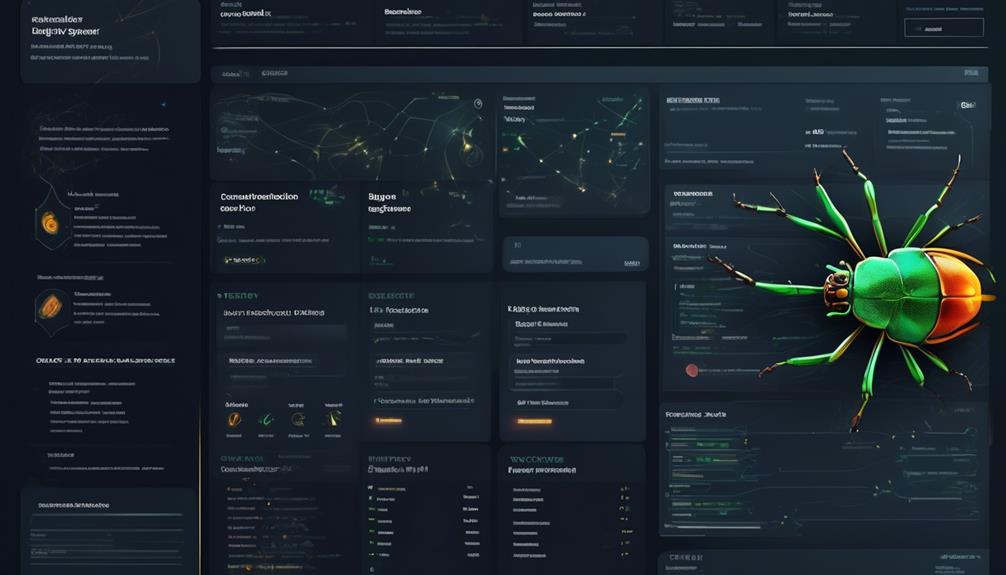Pairing BDD with TDD lets you clarify requirements while catching bugs early. You start by writing plain-language scenarios in BDD to define expected behaviors, then turn those into automated tests with TDD. This approach guarantees your development is guided by clear, shared understanding and verified through rigorous testing. Together, they boost quality, transparency, and collaboration. Keep exploring to see how this powerful combo can transform your development process.
Key Takeaways
- Combining BDD and TDD creates a shared understanding of requirements and ensures tests verify expected behaviors effectively.
- BDD’s plain-language scenarios guide TDD’s test creation, aligning development closely with user needs.
- The integration enhances early defect detection and continuous refinement, boosting overall product quality.
- Automated tests derived from behavior scenarios provide reliable, executable specifications that prevent misunderstandings.
- This pairing fosters a disciplined, transparent workflow, doubling confidence in delivering high-quality, value-driven software.

Many development teams rarely consider how combining Behavior-Driven Development (BDD) with Test-Driven Development (TDD) can enhance their workflow. Integrating these methodologies isn’t just about adding extra testing layers; it’s about creating a synergy that improves both quality and collaboration. As you adopt behavior driven development alongside test driven development, you’ll notice that your team’s understanding of requirements deepens, and your tests become more meaningful. BDD focuses on specifying the expected behavior of features in plain language, making it accessible to non-developers and stakeholders alike. TDD, on the other hand, emphasizes writing tests before code, ensuring you develop with a clear focus on functionality from the start. When you combine them, you get an extensive approach where behavior specifications inform the development process, and tests ensure those behaviors are met precisely.
In practice, you begin with behavior driven development by writing feature scenarios in plain language, often using tools like Gherkin. These scenarios describe how users will interact with your system, giving everyone a shared understanding of the goals. Then, you apply test driven development by translating those scenarios into automated tests—unit tests, specifically—that guide your coding. This sequence means your tests aren’t just technical checks but directly reflect the intended behaviors, bridging the gap between technical and non-technical team members. The key advantage here is clarity: everyone knows what’s expected, and your tests serve as executable specifications. As you write code to pass these tests, you’re ensuring your implementation aligns with the specified behaviors, maintaining a tight feedback loop that reduces misunderstandings and rework. Additionally, understanding essential oils for specific health issues can inspire new ways of thinking about comprehensive testing strategies.
Furthermore, pairing behavior driven development with test driven development encourages continuous refinement. As you develop, you can update your feature scenarios based on new insights or changing requirements, and then adjust your tests accordingly. This iterative process keeps your project adaptable and aligned with actual user needs. You also benefit from early defect detection; since tests are written upfront, bugs are caught soon after they’re introduced, saving time and resources later. Over time, this combination fosters a culture of quality and transparency, as everyone can see the current state of features through human-readable scenarios and automated test results.
Ultimately, embracing both behavior driven development and test driven development transforms your development process into a more disciplined, collaborative, and quality-focused effort. The result: a product that better meets user expectations with fewer surprises and higher confidence in its stability. When you harness the strengths of both methodologies, you’re not just doubling your testing efforts—you’re doubling your assurance of delivering value.
Frequently Asked Questions
How Do BDD and TDD Complement Each Other in Practice?
You’ll find that behavior driven development (BDD) and test driven development (TDD) complement each other by focusing on different aspects of quality. TDD helps you write tests for individual functions, ensuring code correctness. Meanwhile, BDD centers on describing system behavior from the user’s perspective. Together, they create an all-encompassing testing approach, improving code reliability and aligning development with user needs for a more robust product.
What Are Common Challenges When Integrating BDD With TDD?
When integrating BDD with TDD, you might face challenges like maintaining a consistent test environment, which can cause discrepancies between tests. Additionally, ensuring stakeholder engagement is essential; if they’re not involved in defining behaviors, tests may lack clarity. Balancing these methods requires clear communication and proper setup, but overcoming these hurdles leads to better collaboration and higher-quality software.
Which Tools Best Support Pairing BDD With TDD Workflows?
Imagine building a bridge with the right tools—you’ll need behavior driven tools like Cucumber or SpecFlow, which align testing with user stories. Test automation frameworks such as JUnit, NUnit, or Behave support seamless integration, making BDD and TDD workflows smoother. These tools help you catch issues early, boost collaboration, and guarantee your software meets expectations faster. Using the right combo is like having a trusted toolkit for a sturdy, reliable bridge.
How Does Team Collaboration Improve With Combined BDD and TDD?
You’ll notice team collaboration improves when combining BDD and TDD because it reduces communication barriers and aligns everyone on the same goals. By using test automation, your team can quickly verify features and share understanding through readable, behavior-driven scenarios. This approach fosters better communication, speeds up feedback, and guarantees quality is built into every stage, making collaboration smoother and more effective.
Can BDD and TDD Be Used Effectively in Agile Environments?
Think of BDD and TDD as a dynamic duo, perfectly suited for agile environments. You can use them effectively by integrating test automation into your workflow, ensuring rapid feedback and continuous improvement. This combination promotes team alignment, as everyone understands and collaborates on the requirements and tests. When used together, BDD and TDD turn testing into a powerful engine that keeps your team agile, responsive, and focused on delivering quality software.
Conclusion
By combining BDD and TDD, you’re not just testing code—you’re shaping better software with clearer communication and higher quality. This pairing allows you to catch issues early, make sure your features meet user needs, and streamline your development process. The theory holds true: integrating these practices truly doubles your quality punch. When you embrace both, you empower yourself to deliver reliable, user-focused products faster and more confidently. Give it a try—your projects will thank you.









